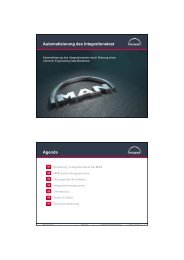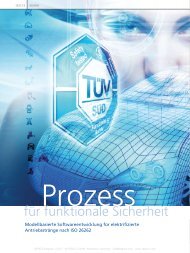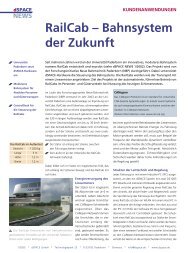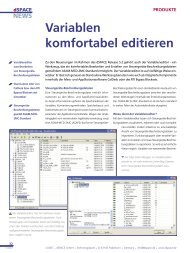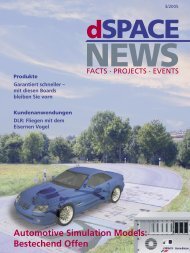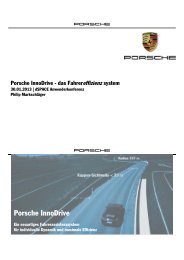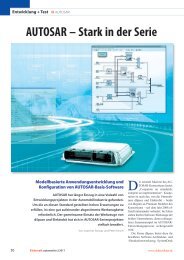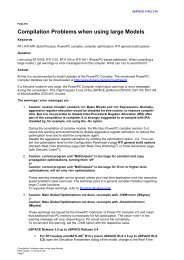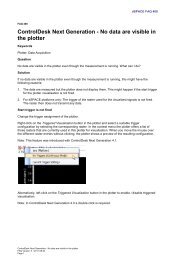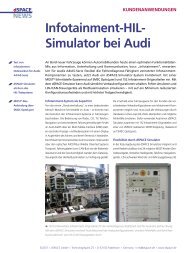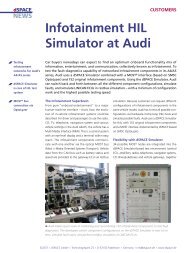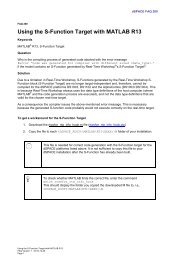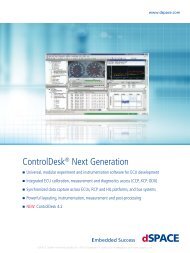magazinE - dSPACE
magazinE - dSPACE
magazinE - dSPACE
You also want an ePaper? Increase the reach of your titles
YUMPU automatically turns print PDFs into web optimized ePapers that Google loves.
pAGe 30 DARpA URBAN CHALLeNGe<br />
vehicle called Caroline. The vehicle<br />
body is based on a VW Passat and<br />
equipped with special sensors such<br />
as multiple laser scanners, cameras,<br />
radar and LIDAR sensors to detect its<br />
environment. A highperformance<br />
GPS receiver is also used to ensure<br />
that the vehicle’s current position is<br />
always known precisely. The team<br />
used the <strong>dSPACE</strong> MicroAutoBox as a<br />
development tool for the control<br />
system (longitudinal and latitudinal<br />
dynamics). This allowed various<br />
control algorithms to be evaluated<br />
quickly by means of rapid prototyping.<br />
The team got the project up and<br />
running within one year.<br />
The challenge was organized in<br />
several stages. The first critical test<br />
was the site visit, a kind of quarterfinal.<br />
The team went to San<br />
Antonio, Texas for just four weeks<br />
in June 2007 to perform intensive<br />
testing at the South West Research<br />
Institute. On the day of the site<br />
visit, the vehicle had to pass various<br />
tests on a circular track.<br />
As project leader, Jörn Marten Wille from<br />
Team CarOLO at the Technische Universität<br />
Braunschweig was responsible for the<br />
development of vehicle control<br />
(longitudinal and latitudinal control and<br />
trajectory generation).<br />
“ Within a year and a half, we succeeded in<br />
converting a normal, offthepeg Passat into<br />
an automotive robot.”<br />
Then the team returned to Germany<br />
to do further development work on<br />
the vehicle. About five weeks before<br />
the actual challenge at the end of<br />
October, the team flew to San<br />
Antonio again to perform final tests.<br />
A few days before the start of the<br />
National Qualification Event (a kind<br />
of semifinal) at the end of October,<br />
the team set off for Victorville,<br />
California. For days, the teams had<br />
to pass tests set up by the DARPA<br />
jury members on unknown terrain.<br />
Of the 100 teams that originally<br />
entered for the event, only 36<br />
were still around in the semifinal.<br />
11 of these were invited to the<br />
finals, which took place on<br />
November 3, 2007.<br />
Jörn Marten Wille, Team CarOLO, Technische Universität Braunschweig<br />
During the race: the autonomous vehicle<br />
Caroline encounters one of 50 cars driven by<br />
stunt drivers that DARPA put on the scene<br />
to create a realistic traffic scenario.<br />
The knowhow that the team gathered<br />
while developing Caroline will<br />
go into a followup project that will<br />
be carried out by the Institute of<br />
Control Engineering in cooperation<br />
with the Institute of Aviation and<br />
the Institute of Operating Systems<br />
and Computer Architectures.<br />
Caroline will still be used as a technology<br />
carrier for the new autonomous<br />
vehicle and for further<br />
research on autonomous driving in<br />
urban traffic. It is likely to be quite<br />
a few years, though, before this<br />
scenario is truly mastered. The<br />
Urban Challenge was a big step in<br />
the right direction, but it was only a<br />
very simplified scenario compared to<br />
the traffic conditions in a real city.



